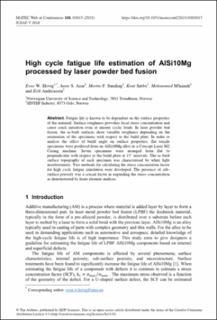| dc.contributor.author | Hovig, Even Wilberg | |
| dc.contributor.author | S. Azar, Amin | |
| dc.contributor.author | Sunding, Martin Fleissner | |
| dc.contributor.author | Sørby, Knut | |
| dc.contributor.author | M'hamdi, Mohammed | |
| dc.contributor.author | Andreassen, Erik | |
| dc.date.accessioned | 2020-11-30T11:40:09Z | |
| dc.date.available | 2020-11-30T11:40:09Z | |
| dc.date.created | 2018-07-05T16:26:12Z | |
| dc.date.issued | 2018 | |
| dc.identifier.issn | 2261-236X | |
| dc.identifier.uri | https://hdl.handle.net/11250/2690178 | |
| dc.description.abstract | Fatigue life is known to be dependent on the surface properties
of the material. Surface roughness provokes local stress concentration and
cause crack initiation even at minute cyclic loads. In laser powder bed
fusion, the as-built surfaces show variable roughness depending on the
orientation of the specimens with respect to the build plate. In order to
analyse the effect of build angle on surface properties, flat tensile
specimens were produced from an AlSi10Mg alloy in a Concept Laser M2
Cusing machine. Seven specimens were arranged from flat to
perpendicular with respect to the build plate at 15° intervals. The as-built
surface topography of each specimen was characterised by white light
interferometry. Two methods for calculating the stress concentration factor
for high cycle fatigue simulation were developed. The presence of subsurface porosity was a crucial factor in expanding the stress concentration
as demonstrated by finite element analysis. | en_US |
| dc.language.iso | eng | en_US |
| dc.publisher | EDP Sciences | en_US |
| dc.rights | Navngivelse 4.0 Internasjonal | * |
| dc.rights.uri | http://creativecommons.org/licenses/by/4.0/deed.no | * |
| dc.subject | Fatigue | en_US |
| dc.subject | Materials | en_US |
| dc.subject | Powder bed | en_US |
| dc.title | High cycle fatigue life estimation of AlSi10Mg processed by laser powder bed fusion | en_US |
| dc.title.alternative | High cycle fatigue life estimation of AlSi10Mg processed by laser powder bed fusion | en_US |
| dc.type | Journal article | en_US |
| dc.description.version | publishedVersion | en_US |
| dc.rights.holder | © The Authors, published by EDP Sciences. This is an open access article distributed under the terms of the Creative Commons
Attribution License 4.0 (http://creativecommons.org/licenses/by/4.0/). | en_US |
| dc.source.pagenumber | 9 | en_US |
| dc.source.volume | 188 | en_US |
| dc.source.journal | MATEC Web of Conferences | en_US |
| dc.identifier.doi | 10.1051/matecconf/201818803015 | |
| dc.identifier.cristin | 1595992 | |
| dc.relation.project | Norges forskningsråd: 248243 | en_US |
| dc.source.articlenumber | 03015 | en_US |
| cristin.unitcode | 7401,80,0,0 | |
| cristin.unitcode | 7401,80,6,2 | |
| cristin.unitname | SINTEF Materialer og kjemi | |
| cristin.unitname | Materialfysikk. Oslo | |
| cristin.ispublished | false | |
| cristin.fulltext | preprint | |
| cristin.qualitycode | 0 | |

